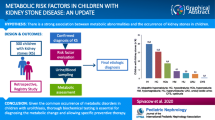Abstract
Background
Idiopathic or benign hematuria is diagnosed in children after all other possible causes have been ruled out and test results for renal or urologic pathologies are negative.
Methods
To identify possible urinary risk factors for hematuria in children, we retrospectively evaluated clinical onset, family history, and metabolic risk factors of 60 children with idiopathic hematuria but without renal stones or other pathologic conditions that could explain the hematuria. All patients followed the same ambulatory protocol at that used to evaluate kidney stone-formers.
Results
Seven patients had microhematuria, three patients each had microhematuria and gross hematuria, and the remaining 50 patients had gross hematuria onset. A family history of stone disease was found in 63 % of the children. At least one urinary metabolic abnormality was present in 49 patients, while 11 patients had no metabolic abnormality. The most common urinary risk factor was idiopathic hypercalciuria (single or associated), which was found in 43.5 % of patients, followed by hypocitraturia (single or associated), present in 31.7 %. Unduly acidic urine pH as a single abnormality was found in 10 % of this pediatric patient population. We also found hyperoxaluria and, less frequently, hypomagnesuria, and hyperuricosuria.
Conclusions
Asymptomatic idiopathic hematuria in pediatric patients may often be associated to different urinary biochemical abnormalities, similar to what is observed in pediatric kidney stone-formers.
Similar content being viewed by others
References
Vehaskari VM, Rapola J, Koskimies O, Savilahti E, Vilska J, Hallman N (1979) Microscopic hematuria in school children: epidemiology and clinicopathologic evaluation. J Pediatr 95:676–684
Diven SC, Travis LB (2000) A practical primary care approach to hematuria in children. Pediatr Nephrol 14:65–72
Fitzwater DS, Wyatt RJ (1994) Hematuria. Pediatr Rev 15:102–108
Kalia A, Travis LB, Brouhard BH (1981) The association of idiopathic hypercalciuria and asymptomatic gross hematuria in children. J Pediatr 99:716–719
Roy S III, Stapleton FB, Noe HN, Jerkins G (1981) Hematuria preceding renal calculus formation in children with hypercalciuria. J Pediatr 99:712–715
Stapleton FB, Roy S III, Noe HN, Jerkins G (1984) Hypercalciuria in children with hematuria. N Engl J Med 310:1345–1348
Praga M, Alegre R, Hernandez E, Morales E, Dominguez-Gil B, Carreño A, Andrés A (2000) Familial microscopic hematuria caused by hypercalciuria and hyperuricosuria. Am J Kidney Dis 35:1–8
Perrone HG, Stapleton FB, Toporovski J, Schor N (1997) Hematuria due to hyperuricosuria in children: 36 month follow up. Clin Nephrol 48:288–291
Voghenzi A, Bezzi TM, Luscardi P, Soriani S (1992) Acquired hyperoxaluria and hematuria in children. Pediatr Nephrol 6:356–357
Ingelfinger JR, Davis AE, Grupe WE (1977) Frequency and etiology of gross hematuria in a general pediatric setting. Pediatrics 59:557–561
Dodge WF, West EF, Smith EH, Bunce H (1976) Proteinuria and hematuria in school children: epidemiology and early natural history. J Pediatr 88:327–347
Curhan GC, Willett WC, Rimm EB, Stampfer MJ (1993) A prospective study of dietary calcium and other nutrients and the risk of symptomatic kidney stones. N Engl J Med 328:833–838
Moreno JA, Yuste C, Gutiérrez E, Sevillano ÁM, Rubio-Navarro A, Amaro-Villalobos JM, Praga M, Egido J (2015) Haematuria as a risk factor for chronic kidney disease progression in glomerular diseases: a review. Pediatr Nephrol. doi:10.1007/s00467-015-3119-1
Praga M, Martínez MA, Andrés A, Alegre R, Vara J, Morales E, Herrero JC, Novo O, Rodicio JL (1998) Association of thin basement membrane nephropathy with hypercalciuria, hyperuricosuria and nephrolithiasis. Kidney Int 54:915–920
Spetie DN, Nadasdy T, Nadasdy G, Agarwal G, Mauer M, Agarwal AK, Khabiri H, Nagaraja HN, Nahman NS Jr, Hartman JA, Hebert LA (2006) Proposed pathogenesis of idiopathic loin pain-hematuria syndrome. Am J Kidney Dis 47:419–427
Spivacow FR, Negri AL, del Valle EE, Calviño I, Fradinger E, Zanchetta JR (2008) Metabolic risk factors in children with kidney stone disease. Pediatr Nephrol 23:1129–1133
del Valle EE, Spivacow FR, Zanchetta JR (1995) Evaluación metabólica ante el primer episodio de litiasis renal. Medicina (Buenos Aires) 55:69–74
Perrone HC, Ajzen H, Toporovski J, Schor N (1991) Metabolic disturbance as a cause of recurrent hematuria in children. Kidney Int 39:707–710
Escribano J, Balaguer A, Martín R, Feliu A, Espax R (2004) Childhood idiopathic hypercalciuria: clinical significance of renal calyceal microlithiasis and risk of calcium nephrolithiasis. Scand J Urol Nephrol 38:422–426
Pan CG (2006) Evaluation of gross hematúria. Pediatr Clin North Am 53:401–412
Spivacow FR, del Valle EE, Negri AL, Fradinger E, Abib A, Rey P (2015) Biochemical diagnosis in 3040 kidney stone-formers in Argentina. Urolithiasis 43(4):323–330
Stapleton FB (1990) Idiopathic hypercalciuria: association with isolated hematuria and risk for urolithiasis in children. Kidney Int 37:807–811
Youn T, Trachtman H, Gauthier B (2006) Clinical spectrum of gross hematuria in pediatric patients. Clin Pediatr 45:135–141
Bergstein J, Leiser J, Andreoli S (2005) The clinical significance of asymptomatic gross and microscopic hematuria in children. Arch Pediatr Adolesc Med 159:353–355
Tefekli A, Esen T, Ziylan O, Erol B, Armagan A, Ander H, Akinci M (2003) Metabolic risk factors in pediatric and adult calcium oxalate urinary stone-formers: is there any difference? Urol Int 70:273–277
VanDervoort K, Wiesen J, Frank R, Vento S, Crosby V, Chandra M, Trachtman H (2007) Urolithiasis in pediatric patients: a single centre study of incidence, clinical presentation and outcome. J Urol 177:2300–2305
Author information
Authors and Affiliations
Corresponding author
Ethics declarations
Conflict of interest
The authors declare that they have no conflict of interest.
Ethics statement
Due to the retrospective nature of the study, there was no requirement for ethical review board approval. Written informed consent was signed by the legal guardians of all participating patients to use their clinical and laboratory data for scientific purposes.
Rights and permissions
About this article
Cite this article
Spivacow, F.R., del Valle, E.E. & Rey, P.G. Metabolic risk factors in children with asymptomatic hematuria. Pediatr Nephrol 31, 1101–1106 (2016). https://doi.org/10.1007/s00467-015-3282-4
Received:
Revised:
Accepted:
Published:
Issue Date:
DOI: https://doi.org/10.1007/s00467-015-3282-4




